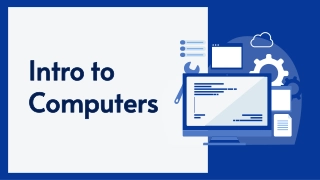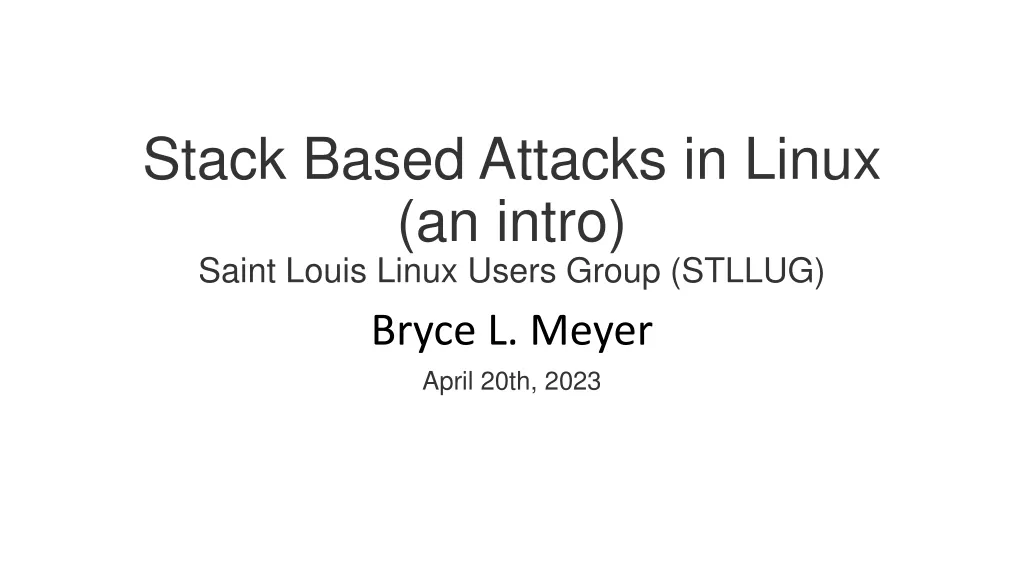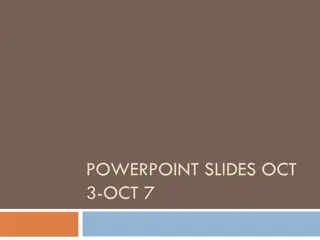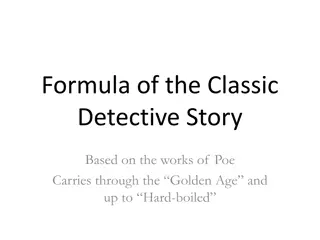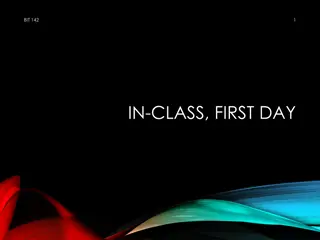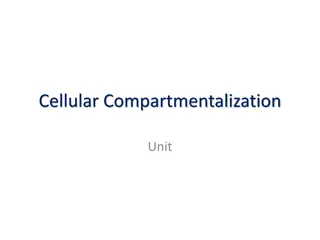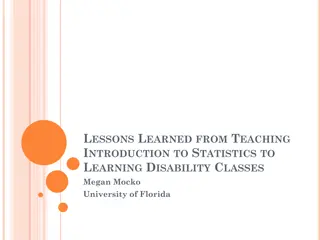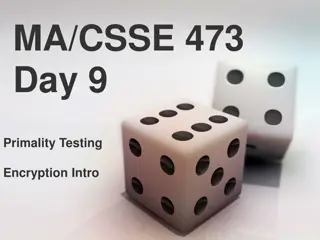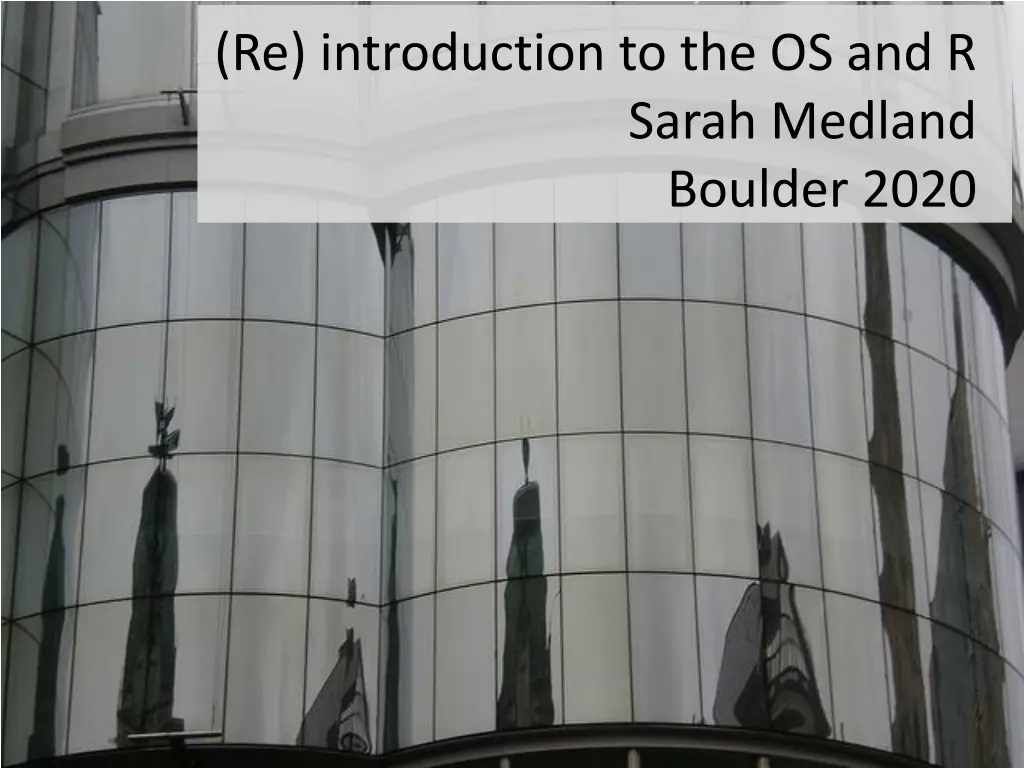
Exploring OS and R: Workshops, Linux, and Server Tips
Dive into the world of operating systems and R programming with Sarah Medland, where workshops offer valuable insights and hands-on experiences. Learn about Debian OS, Linux, file hygiene, and server best practices. Discover the importance of collaboration, diverse skill sets, and making the most of your workshop experience. Stay informed about upcoming sessions on Plink, GWAS, genetic relatedness, and more. Remember, Unix systems are case-sensitive, and file format hygiene is crucial. Don't hesitate to seek guidance from sysadmins to avoid server mishaps. Embrace the Unix philosophy of empowering users to explore and innovate.
Download Presentation

Please find below an Image/Link to download the presentation.
The content on the website is provided AS IS for your information and personal use only. It may not be sold, licensed, or shared on other websites without obtaining consent from the author. If you encounter any issues during the download, it is possible that the publisher has removed the file from their server.
You are allowed to download the files provided on this website for personal or commercial use, subject to the condition that they are used lawfully. All files are the property of their respective owners.
The content on the website is provided AS IS for your information and personal use only. It may not be sold, licensed, or shared on other websites without obtaining consent from the author.
E N D
Presentation Transcript
(Re) introduction to the OS and R Sarah Medland Boulder 2020
Getting the most out of the workshop Ask questions!!! Don t sit next to someone you already know Work with someone with a different skillset and different experience level Use the workshop laptop You will have access to your files after you leave Come to the social functions Ask questions!!!
I work in Brisbane at QIMR Sarah Medland
Morning sessions Optional Feel free to wander in and out/check email etc Topics Shift in response to feedback Tomorrow: Plink and Genetic relatedness Wednesday: GWAS and LDscore Thursday: Polygenic Risk Scores Friday: Modelling challenges and solutions
This years OS Debian (linux) Free Many free software packages available Open office R PSPP Terminal Based on Unix long and venerable history http://en.wikipedia.org/wiki/Unix
Close but not the same Most basic shortcuts will work crtl+C for copy crtl+V for paste etc Supports folder based navigation /\ BIG PROBLEM is \ vs / You will have used some version of unix previously
File hygiene is very important Files are stored in Unix format not DOS or Mac Changes the line ending characters Use dos2unix, unix2dos, mac2unix, unix2mac to change formats Can use the file command to check format Unix systems are case sensitive! NO SPACES in your file/directory names!! Wildcards ie dos2unix *.dat
It is (relatively) easy to break a server and very easy to break a queuing system So it is worth doing a bit of googling and talking to your sysadmins before jumping in. UNIX was not designed to stop its users from doing stupid things, as that would also stop them from doing clever things. Doug Gwyn
What is it? R is an interpreted computer language. System commands can be called from within R R is used for data manipulation, statistics, and graphics. It is made up of: operators (+ - <- * %*% ) for calculations on arrays & matrices large, coherent, integrated collection of functions facilities for making unlimited types of publication quality graphics user written functions & sets of functions (packages); 800+ contributed packages so far & growing
Advantages o Fast** and free. o State of the art: Statistical researchers provide their methods as R packages. SPSS and SAS are years behind R! o great graphics. o Active user community o Excellent for simulation, programming, computer intensive analyses, etc. o Forces you to think about your analysis. o Interfaces with database storage software (SQL)
Disadvantages o Not user friendly @ start - steep learning curve, minimal GUI. o No commercial support; figuring out correct methods or how to use a function on your own can be frustrating. o Easy to make mistakes and not know. o Working with large datasets is limited by RAM!!! o Data prep & cleaning can be messier & more mistake prone in R vs. SPSS or SAS o Hostility on the R listserve
R-help listserve.... Once you appreciate that you have seriously misread the page, things will become a lot clearer. (2005) You will need to do your homework a lot more carefully, as it seems you don't have enough knowledge to recognise the errors you are making. (2007) Well, don't try to use a Makefile as you do not know what you are doing. (2013) It is user lack-of-understanding: there is no error here. (2013)
Using R this week R-studio http://rstudio.org/
Setting this up at home Install R first Install R studio Install packages
Start up R via R studio 4 windows: Syntax can be opened in regular txt file - saved Terminal output & temporary input - usually unsaved Data manager details of data sets and variables Plots etc
Final Words of Warning Using R is a bit akin to smoking. The beginning is difficult, one may get headaches and even gag the first few times. But in the long run, it becomes pleasurable and even addictive. Yet, deep down, for those willing to be honest, there is something not fully healthy in it. --Francois Pinard
How to use help in R? R has a help system built in. If you know which function you want help with simply use ?_______ or help(_____) with the function in the blank. ?hist. help(hist) If you don t know which function to use, then use help.search( _______ ). help.search( histogram ).
Importing Data First make sure your data is in an easy to read format such as space, tab or CSV Use code: D <- read.table( ozbmi2.txt ,header=TRUE) D <-read.table( ozbmi2.txt ,na.strings= - 99 ,header=TRUE) D <- read.table( ozbmi2.csv , sep= , header=TRUE) D <- read.csv( ozbmi2.csv , header=TRUE)
Exporting Data Tab delimited write.table(D, newdata.txt ,sep= \t ) csv write.csv(D, newdata.csv ) Other options include writing to xls, spss, sas and other formats
Checking data #list the variables in D names(D) # dimensions of D dim(D) # print the first 10 rows of D head(D, n=10) #referring to variables in D #format is Object$variable head(D$age, n=10)
Basic Manipulation #You can make new variables within an existing object D$newage<- D$age*100 #Or overwrite a variable D$age<- D$age*100 #Or recode a variable #D$catage <- ifelse(D$age > 30, c("older"), c("younger"))
Describing data #Mean and variance mean(D$age, na.rm =TRUE) var(D$age , na.rm =TRUE)
Describing data A bit more info summary(D$age) summary(D$age[which(D$agecat==1)]) What about a categorical variable table(D$agecat) table(D$agecat,D$zyg)
Some basic analysis Correlations anyone? cor(D$wt1,D$bmi1, use="complete") cor(D$ht1,D$bmi1, use="complete")
Basic plots Histogram #basic hist(D$age) #basic hist(D$age, breaks=12, col= red ) # Add labels hist(D$age, breaks=12, col='red', xlab='age in years',main='Histogram of age )
Looking at your data... #Kernal density plot density(D$age, na.rm = "TRUE") # returns the density data
Looking at your data... #Kernal density plot by zyg? library(sm) attach(D) # create value labels zyg.f <- factor(zyg, levels= seq(1,5), labels = c("MZF", "MZM", "DZF", "DZM", "DZOS")) # plot densities sm.density.compare(age, zyg, xlab="Years") title(main="Years by ZYG") # add legend colfill<-c(2:(2+length(levels(zyg.f)))) legend(.8,3, levels(zyg.f), fill=colfill)
Huh what? > library(sm) Error in library(sm) : there is no package called 'sm' > sm.density.compare(age, zyg, xlab="Years") Error: could not find function "sm.density.compare"
Adding a package... install.packages()
Looking at your data... #Kernal density plot by zyg? library(sm) attach(D) # create value labels zyg.f <- factor(zyg, levels= seq(1,5), labels = c("MZF", "MZM", "DZF", "DZM", "DZOS")) # plot densities sm.density.compare(age, zyg, xlab="Years ) title(main="Years by ZYG") # add legend colfill<-c(2:(2+length(levels(zyg.f)))) legend(.8,3, levels(zyg.f), fill=colfill)


